MAP Microtube for Automated Capillary Blood Processing
These tubes are designed for automated hematology testing using capillary blood samples from pediatric and difficult-draw patients. Each BD Microtainer MAP (Microtube for Automated Process) Microtube contains a K2 EDTA additive to ensure accurate anticoagulation and is engineered for compatibility with high-throughput analyzers.
These automation-ready tubes collect between 250 and 500 microliters, supporting sample precision without requiring full venipuncture. The clear tube variant (item #363706) enables visual fill confirmation, while the translucent version (item #365974) is ideal for light-sensitive workflows.
Optimized for closed-system lab operations, BD Microtainer MAP Microtubes feature a lavender cap and are molded to fit standardized automation-compatible racks and barcode scanners. This design minimizes manual handling errors, accelerates turnaround time, and enhances traceability throughout the diagnostic process. Also known as BD Microtainer K2EDTA tubes, they are a trusted solution for pediatric clinics, outpatient labs, and any setting using an EDTA microtube for automated hematology analyzers.
Vitality Medical offers a variety of blood collection tubes for safe sampling. Provide maximum protection and efficiency to the collection process and buy the BD Microtainer MAP Microtubes for Automated Process today!
Features and Benefits
- Minimizes Draw Volume for Pediatrics
- Reduces Relabeling and Orientation Errors
- Ideal for Automated CBC and Platelet Testing
- Streamlines Operations With Automatic Processing
- Bold 250–500 µL Markings for Small-Volume Blood Draws
- K2 EDTA Anticoagulant Additive for Sample Integrity
- Sterile, Single-Use Format Improves Laboratory Hygiene
- Environmentally-Friendly Recyclable Packaging
- Color-Coded Lavender Cap and Transparent/Translucent Tube
Specifications
- Manufacturer: Becton Dickinson
- Brand: BD Microtainer® MAP
- Country of Origin: Unknown
- Additive: K2 EDTA Additive
- Application: Capillary Blood Collection Tube
- Cap Color: Lavender
- Color Code: Lavender
- Closure Type: BD Microgard™ Closure
- Cap Material: High Density Polypropylene
- Tube Material: Polypropylene
- Tube Color: Transparent / Translucent
- Type: Hematology
- UNSPSC Code: 41121709
- Volume: 250 µL to 500 µL
- GTIN (363706) - Box of 50: 30382903637066
- GTIN (363706) - Box of 200: 50382903637060
- GTIN (365974) - Box of 50: 30382903659747
- GTIN (365974) - Box of 200: 50382903659741
Dimensions (363706)
- Length: 75 mm
- Width: 13 mm
Dimensions (365974)
- Length: 46 mm
- Width: 15.3 mm
Additional Resources
30-Day Returns
- 30-day return policy
- Items must be unopened
For more info view the return policy
Fast Shipping & Handling Most orders are processed and shipped within 24 hours!
Comparison Table
Use the table below to compare the two BD Microtainer MAP Microtube options by material, visibility features, and recommended use cases.
| SKU | Tube Material | Visual Features | Ideal Use Case |
|---|---|---|---|
| 363706 | Clear | Transparent fill lines visible | General hematology workflows |
| 365974 | Translucent | Light filtration for sensitive samples | Light-sensitive specimen handling |
Frequently Asked Questions (FAQs)
What are BD’s suggested centrifugation times and speeds?
Spin microtainer tubes with gel at 6000-15000 relative centrifugal force (RCF) for 90 seconds and non-gel tubes at a minimum of 2000 RCF for 3 minutes.
What is the average amount of K2EDTA in the tubes?
Approximately 1.0-mg — enough to anticoagulate blood volume from 250-500 μL.
What kind of plastic material is used to manufacture BD Microtainer tubes?
The tubes are polypropylene, while the caps are high-density polyethylene.
How long do tubes remain stable after blood collection?
Samples can remain in Microtainer® tubes at room temperature for up to four hours before performing hematological determinations.
Can the tubes be used for lead determination?
The BD Microtainer K2EDTA with Microgard™ closure (365974) is approved for lead, with a background amount at less than 1 ng per tube.
What is BD Microtainer’s suggested order of draw?
CLSI "Procedures and Devices for the Collection of Diagnostic Capillary Blood Specimens" (H4-A6 Vol. 28 #25 September 2008) recommends:
- EDTA tubes
- Other additive tubes
- Serum tubes
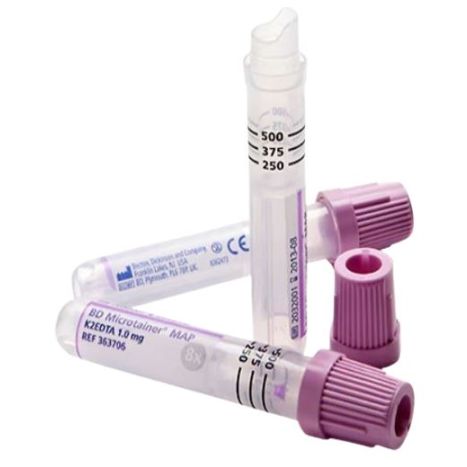
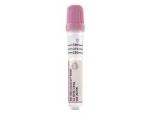

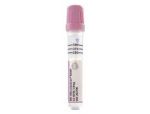

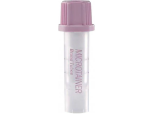

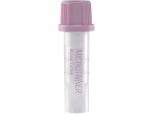

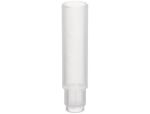

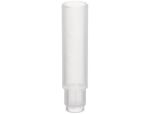


Login and Registration Form